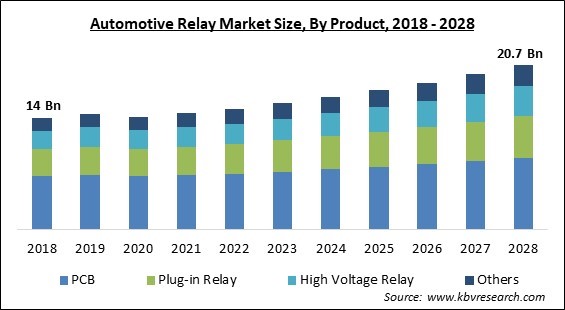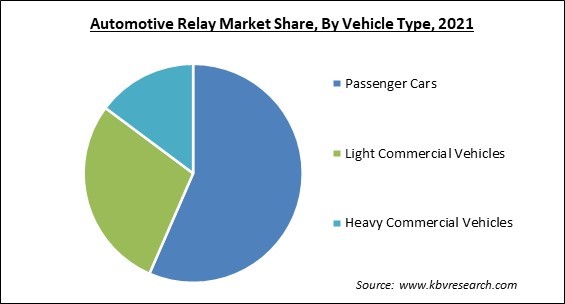The Global Automotive Relay Market size is expected to reach $20.7 billion by 2028, rising at a market growth of 5.3% CAGR during the forecast period.
Automotive relay is a common type of electromechanical relay, which can be employed in all forms of vehicles, including cars, trucks, vans, and trailers. In vehicular applications, they make it possible for a small current flow circuit to manage and run a larger current circuit. Find SPDT and SPST automotive relays at Future Electronics. These relays come in a variety of termination styles, nominal coil voltages, and maximum contact currents.

Relays are electrically powered switches that can be controlled by a computer, control module, or another switch. An automobile relay's function is to automate this ability to turn electrical circuits on and off at specific periods. The real advantage of a relay, however, goes beyond automation. It also has the capacity to simultaneously switch several circuits, including those with various voltage types, within a single relay.
Switches that are operated electronically are known as relays. Electromechanical relays known as automotive relays are widely utilized in a variety of vehicles, including cars, vans, trucks, and trailers. In vehicular applications, they make it possible for a circuit with a small current flow to manage and run a circuit with a higher current. Relays in a vehicle may vary depending on the features that are added to it. Relays placed in vehicles have increased significantly over the past few years as a result of technological advancements and rising demand for implementing cutting-edge automotive applications.
These electrically driven switches use electromagnetism to convert weak electric inputs into strong currents. Electromagnets are turned on during this conversion process in order to shape or alter the current circuits. Relays effectively serve as a switch or an amplification tool for the electrical current by utilizing weak inputs to power a more powerful current. These are based on the preferred uses. Automotive Relays are used to automate the power switch that turns electric circuits on and off at different times.
The COVID-19 pandemic compelled governments around the world to impose stringent import-export bans on products used as raw materials for the majority of the pandemic year. This caused the availability of crucial raw materials for automotive components to suddenly diminish. The COVID-19 pandemic severely affected aviation production and sales, which had a detrimental impact on the market for automotive relays. As a result, supply chains, as well as production schedules, were substantially disrupted. Governments across the world enforced stringent lockdowns and made social seclusion mandatory to stop the COVID-19 virus from spreading. Therefore, the automotive relay market is estimated to rapidly grow in the coming years.
The number of semiconductors used in vehicles has grown at a rate that is approximately twice as fast as the manufacture of automobiles. As a result of the increase in electronic components, ECU complexity has increased, which has an instant impact on electromagnetic compatibility (EMC) targets. For instance, the greater use of relays in vehicles is a result of the automotive industry's shift toward X-by-wire systems (brake, throttle, and gear-shift). On average, a passenger car requires roughly 30 relays.
One of the key factors that are driving the growth o the market is the expanding demand for electric vehicles all over the world. Increased sales of electric vehicles are being driven by more strict emission laws. Relays are now required for electric vehicles due to the increase in hybridization by automakers. Even though EVs are less common than ICEs, numerous initiatives by governments throughout the world to boost sales of electric vehicles have resulted in a rapid rise in the number of electric vehicles on the road.
The market for automotive relays is primarily constrained by the failure of these devices to operate in severe temperatures, such as extreme cold and excessive heat. Extreme heat causes the relay to melt or shatter, resistance to grow, and the signal to become too weak, which causes failures. On the other hand, resistance is decreased and it becomes stable when it is brought to an ideal temperature. Additionally, high cold is not good for relay since they stop working. It can operate at temperatures as low as -25°C and as high as +150°C on average. As a result, various countries all over the world favor automobiles with fewer semiconductors and relays.

On the basis of Propulsion, the Automotive Relay Market is bifurcated into ICE and Electric & Hybrid. In 2021, the hybrid & electric segment garnered a significant revenue share of the automotive relay market. Due to the rising demand for hybrid and electric vehicles, manufacturers are investing more in the production of solid-state relays rather than the traditional heavy electromechanical relays to meet the demand for sophisticated relays with light-weight and high-performance qualities. A relay state detection circuit for hybrid electric vehicles is offered by the innovation.
Based on the basis of Vehicle Type, the Automotive Relay Market is segregated into Passenger Cars, Light Commercial Vehicles, and Heavy Commercial Vehicles. In 2021, the heavy commercial vehicle segment recorded a substantial revenue share of the automotive relay market. The rising growth of the segment is owing to the increasing growth of the transportation and logistics industry. Due to the rising disposable income of people all over the world, a significant population is migrating from rural areas to urban areas.
By the Application, the Automotive Relay Market is segmented into Powertrain System, Body and Chassis, Convenience, Safety & security, and Others. In 2021, the convenience segment registered a significant revenue share of the automotive relay market. For the convenience of the driver, new HVAC systems in automobiles come with a variety of switches. A convenience system with a high adoption rate is electronic power steering, which has features like a high level of compatibility, a big switching capacity, and a space-saving design.
On the basis of Product, the Automotive Relay Market is divided into PCB, Plug-in relay, High voltage relay, and Others. In 2021, the plug-in relay segment procured a substantial revenue share of the automotive relay market. The rising growth of the segment is a result of the fact that this type of relays can eliminate the need for expensive and space-consuming high-amperage wires and switches.
| Report Attribute | Details |
|---|---|
| Market size value in 2021 | USD 14.6 Billion |
| Market size forecast in 2028 | USD 20.7 Billion |
| Base Year | 2021 |
| Historical Period | 2018 to 2020 |
| Forecast Period | 2022 to 2028 |
| Revenue Growth Rate | CAGR of 5.3% from 2022 to 2028 |
| Number of Pages | 274 |
| Number of Tables | 460 |
| Report coverage | Market Trends, Revenue Estimation and Forecast, Segmentation Analysis, Regional and Country Breakdown, Companies Strategic Developments, Company Profiling |
| Segments covered | Product, Vehicle Type, Propulsion, Application, Region |
| Country scope | US, Canada, Mexico, Germany, UK, France, Russia, Spain, Italy, China, Japan, India, South Korea, Singapore, Malaysia, Brazil, Argentina, UAE, Saudi Arabia, South Africa, Nigeria |
| Growth Drivers |
|
| Restraints |
|
Region-Wise, the Automotive Relay Market is analyzed across North America, Europe, Asia-Pacific, and LAMEA. In 2021, Asia-Pacific accounted for the largest revenue share of the automotive relay market. The growth of the regional market is flourishing due to the region's developed automotive sector. In addition, the participation of seasoned key market players would improve the regional economy's position during the forecast period. Increasing product aftermarket demand from nations, like China, would further create enormous market growth possibilities.
Free Valuable Insights: Global Automotive Relay Market size to reach USD 20.7 Billion by 2028
The market research report covers the analysis of key stake holders of the market. Key companies profiled in the report include TE Connectivity Ltd., Fujitsu Limited, Omron Corporation, Panasonic Corporation, Robert Bosch GmbH, Littelfuse, Inc., Denso Corporation, MITSUBA Corporation, LS Automotive Technologies Co., Ltd., and Xiamen Hongfa Electroacoustic Co., Ltd.
By Product
By Vehicle Type
By Propulsion
By Application
By Geography
The Automotive Relay Market size is projected to reach USD 20.7 billion by 2028.
Increasing Technological Advancements In Contemporary Vehicles are driving the market in coming years, however, Tendencies Of Operational Failures In Uneven Weather Conditions restraints the growth of the market.
TE Connectivity Ltd., Fujitsu Limited, Omron Corporation, Panasonic Corporation, Robert Bosch GmbH, Littelfuse, Inc., Denso Corporation, MITSUBA Corporation, LS Automotive Technologies Co., Ltd., and Xiamen Hongfa Electroacoustic Co., Ltd.
The expected CAGR of the Automotive Relay Market is 5.3% from 2022 to 2028.
The PCB segment acquired maximum revenue share in the Global Automotive Relay Market by Product in 2021 thereby, achieving a market value of $9.1 billion by 2028.
The Asia Pacific market dominated the Global Automotive Relay Market by Region in 2021, and would continue to be a dominant market till 2028; thereby, achieving a market value of $7.7 billion by 2028.
Our team of dedicated experts can provide you with attractive expansion opportunities for your business.

